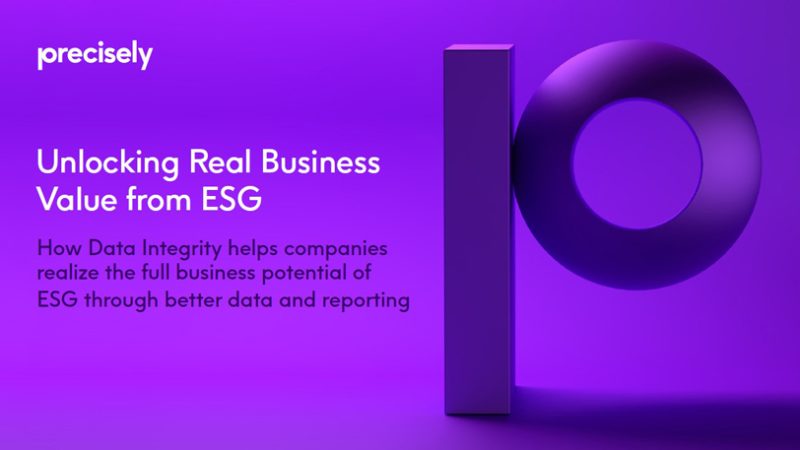eBook
Unlocking Real Business Value from ESG
How Data Integrity helps companies realize the full business potential of ESG through better data and reporting
In recent decades, large organizations’ environmental, social, and governance (ESG) practices have become key business concerns requiring direct, active, and sustained attention from executive management. Far from being a simple question of managing corporate brand image, how a firm addresses ESG concerns can directly impact its hiring practices, profitability, legal liabilities, and even its fundamental ability to do business.
While governments are beginning to introduce formal ESG reporting regulations, the increased scrutiny of corporate ESG impacts is driven by growing public demand. Companies worldwide are expected to be
responsible stewards of the environment, treat employees and communities with respect and fairness, and be financially and ethically trustworthy corporate citizens.
Most importantly, corporations and their top executives are under increasingly heavy pressure from their most important and influential stakeholders to address their ESG impacts. While each stakeholder class may have specific reasons for their concern, the sum of their demands for answers and actions leaves no option but to respond.
Here are a just few examples:
- Investment managers and asset owners demand full disclosure of ESG risks that could impact the long-term value of their holdings
- Financial and stock exchange regulators are concerned about preventing market instability caused by fraudulent and misleading ESG claims and disclosures
- ESG raters, rankers, and reporters can suffer damage to their reputations if they publish investment analyses based on false or incomplete corporate risk disclosures
- Supply chain partners and business customers can also suffer damage to their reputations and revenues if they are involved with a firm with undisclosed serious ESG liabilities
- Consumers and employees strongly prefer to buy from and work for companies with excellent reputations for environmental awareness, ethical and fair business practices, diversity, and alignment with their values
Worldwide concern is already driving the development of increasingly stringent and demanding ESG data collection and reporting regulations that will compel serious corporate attention and response. And these new requirements are neither incremental nor generalized, and meeting them will require a major, if not massive, organizational effort and IT investment for all but the smallest businesses.
In this eBook, we will review significant ESG concerns and issues; explain why complete, accurate, and actionable ESG data is critical for ESG reporting; and explore the range of data and IT processes that must be in place to meet requirements for corporate ESG performance tracking and reporting.

Understanding the full scope of ESG reporting
Organizations must recognize that data scientists and analysts are one part of the equation for deriving value from big data. Of course, sales, marketing, operations, and others Shareholders, insurers, and other business stakeholders have long demanded disclosure of risks and activities that could materially impact a company’s financial performance. Similarly, today’s ESG reporting guidelines and frameworks are based upon the growing realization that an organization’s known and potential ESG-related harms and impacts are material issues of equal importance. This dual focus on financial and ESG exposures is commonly called the principle of ‘double materiality.’
Under current ESG reporting frameworks and laws, the range of ESG issues included and the level of detail at which they are being evaluated are expanding rapidly. Some of the more well known and frequently cited frameworks include detailed listings of metrics that reports are expected to have. These can often extend to requiring corporations to report on ESG issues related to their activities and those of their business partners and suppliers. Moreover, governmental regulations are beginning to require that ESG reports be reviewed and verified by independent auditors, just as is necessary for financial reports.
The net of all this is that it will be increasingly challenging and time-consuming to identify, track, validate, and report on ESG issues. Here are just a few examples of top-level topics and issues included in many ESG reporting frameworks and regulations:
| Environmental: Overall environmental impact and responsibility |
|
| Social: Relationships with and impacts upon internal and external stakeholders |
|
| Governance: KPIs and data related to assurance of legal, ethical, and transparent management of a company |
|
– Craig Hupper, Senior Vice President and Managing Director; Head of Sustainability and Resilience, TransRe
Doing better by doing good
Upgrading and expanding the business and IT competencies required to successfully and reliably gather, analyze, and report on ESG-related data is an urgent, business-critical mission. But don’t fall into the trap of viewing the necessary investments and workloads as burdensome overhead expenses that only serve to put yet more drag on profitability.
At first, that may sound implausible. But dig into the details, and the
reasons become clear.
- Quantifying and reporting on your ESG KPIs requires reviewing and collecting relevant data from your operations across all business units. In the process, you will inevitably learn about problems, inefficiencies, and exposures representing substantial risks to your business. Such knowledge allows you to take proactive and informed action to resolve them.
- Because ESG-focused monitoring and data collection must be an ongoing, permanent business process, new and emerging problems in your operations will also come to light much more quickly, enabling faster, less costly, and time-consuming resolution.
- As with financial data required for audits and reporting, standardized ESG record-keeping procedures, data definitions and formats, security protocols, etc., must be established and followed. Data quality and reliability naturally improve when stricter controls are in place.
- Moreover, because ESG reporting data must be sourced from many different, widely distributed business units within your company, those positive impacts on data quality and reliability will accrue just as broadly.
- For all publicly traded companies and any privately held firms with broad public brand recognition, proactively and transparently reporting on your ESG issues and the actions you take to address them builds trust with your key stakeholders. Such trust translates directly into easier access to capital and funding, effective employee recruitment and retention, cost-efficient marketing, greater consumer loyalty, and other advantages and efficiencies contributing to greater profitability.
The Core Challenges of ESG Compliance and Reporting
It is no longer enough to state your corporate ESG ‘goals’ and aspirations. To have any chance of delivering comprehensive and verifiable ESG reporting and to avoid deliberate or accidental ‘greenwashing’ (that is, making ESG claims that are not supported by the facts), organizations must realign their IT processes and provide their employees with the knowledge and tools they will need to meet internally and externally imposed ESG mandates.
Measuring and reporting ESG efforts and impacts cannot be addressed as a collection of add-on/overlay processes within an organization. It is not a side project. Nor can it be handled as post-processing, that is, just reaching into whatever ESG-related data is on hand at the end of the year and manipulating it to generate reports.
Instead, every department and discipline within an organization must understand the company’s ESG requirements and adjust, update, and expand its processes to ensure the continuous capture, structuring, and delivery of all the data needed to measure and report on ESG performance.
More than manual data-gathering and analysis methods will be required to keep up with ESG reporting and compliance in any but the smallest of organizations. ESG reporting requires highly standardized and structured data supporting year-over-year and long-term trend analysis. As a result, the sheer volume of data that must be gathered, cleansed, standardized, maintained, and kept available for many years precludes manual processing.
Milestone events for enabling ESG reporting
As with any major business process restructuring project, it is important to break the effort into manageable pieces and execute them logically. The process for establishing ESG reporting as a core competency for your business will include the following:
- Identify the specific ESG goals and initiatives that are mandated or align with your organization’s real ESG issues. This requires research and strategic evaluations, which will be unique for each company, industry, and locality. There are so many frameworks and agencies that promote ESG reporting ‘standards’ that you cannot adopt just one, nor can you address them all. Outside experts on ESG issues and reporting may well need to be engaged.
- Once you’ve established key ESG issues and metrics, IT and data management executives must lead their teams through a careful and thorough evaluation of the related data requirements, including where the required ESG data exists, how it is generated, and how its business and technical lineage and other critical metadata is captured and preserved.
- Next is the core work of developing and implementing new and updated business processes for ongoing ESG data identification, collection, and monitoring, as well as the IT infrastructure and data management processes to support them.
- Finally, ESG data analysis and report generation capabilities must be developed, including providing at least architectural, if not operational, support for independent outside audits of the results akin to financial auditing, which are increasingly required.
This is not just ‘a big ask.’ Given how critical to business success ESG reporting has become, it can seem more like an existential crisis for your business. But the silver lining here is that all the time and effort invested to achieve ESG compliance can yield additional real and tangible ROI from more detailed and reliable insights into your data and operational efficiencies.
Data is the foundation for ESG success
Ultimately, the ability to fully, accurately, and consistently report against corporate ESG mandates and targets must be a core competency for your business. And that requires a robust IT framework that enables clear and continuous access and visibility into all the underlying data elements needed for accurate, consistent, and contextualized ESG reporting.
The core challenge is that the data needed for ESG reporting does not exist in friendly, compact, ready-to-ingest packages. The very nature of the subjects at hand, namely Environmental concerns, Social responsibility, and organizational Governance, means that the data required for reporting are diverse and dispersed: qualitative as well as quantitative; structured and unstructured; and are stored on a wide range of platforms and in widely varying formats.
Therefore, ESG compliance and reporting competency can only be achieved by building robust and flexible capabilities in all the key data management areas.
Source: Head of Data Operations & Strategy, Global Banking & Investment Management Group
– Christina Schack, Vontabel
Data integrity is the key
What is data integrity? Data integrity is the overall accuracy, consistency, and context of a data set that ensures it is fit for use. Especially for ESG compliance and reporting, achieving data integrity requires IT systems and processes that allow you to effectively and flexibly achieve several crucially important data management competencies, including:
- Data Integration capabilities for capturing and organizing ESG data from multiple sources and making it available in real-time
- Data Enrichment for combining and aligning your fundamental ESG data with additional data sets to add context and meaning, such as geographic, demographic, or economic data
- Data Governance for positive control over data storage, access, use, exchange between systems, etc., while maintaining privacy, security, and compliance with essential government regulations
- Data Quality standards and controls to ensure all data, including ESG data, is always accurate, complete, and consistent, wherever it is stored and used throughout the
organization
Let’s examine why these are vital for successful ESG compliance reporting.
Data integration
As mentioned earlier, the data required for ESG reporting must be obtained from various sources in many formats. For example, environmental metrics require predominantly quantitative data but must be sourced from multiple systems and data sets.
The environmental metrics demanded by current regulations and frameworks include very specific details regarding things such as the total carbon and chemical emissions from all fuels used for manufacturing operations and logistics; water sourcing, utilization, treatment, and disposition; the ultimate landfill impacts of plastics, paperboard, and other packaging materials included in your products, and many, many more.
Such data will be generated, collected, and stored on disparate platforms across diverse storage systems and with potentially wide variations in formats. And, as if all that were not sufficiently challenging, several of the existing ESG reporting guidelines and forthcoming regulations also require that the same data be collected from upstream suppliers and vendors regarding the finished or raw materials they provide to you.
Similar challenges are present in the data required for compliant reporting of social responsibility and governance metrics. The bottom line is that data integration capabilities are essential. You must be able to collect, transform, and manage ESG-related data of many types from many sources, consistently and reliably, and in real-time.
Data Enrichment
Only some of the data you need for complete and compliant ESG reporting will be directly available within your organization or from vendors and suppliers. Much of it must be sourced from trustworthy third-party sources, standardized, and added to your available data directly in a form that can be used to calculate derived results. This includes enriching ESG analytics and models with data that provide practical context, for example, how environmental issues may impact the evaluation of insurance underwriting risks or potentially harm nearby communities or natural resources.
Similarly, social data like the demographics and diversity of your employees, as well as average hourly wages paid, will need to be supplemented to include data on how the diversity of your employees compares to that of the locations in which they are employed and how wage scales align with their local cost of living.
And once again, this requirement may apply to your in-country employees, those at your internationally based operations, and the employees of your upstream supply chain partners.
This clearly demands developing a robust internal practice for external data acquisition and preparation for use in data enrichment.
Data Governance
Data governance, the structured processes, and the standards required to avoid data chaos are also critical for ESG compliance and reporting. As ESG reporting requirements increase, your data management team will have to deal with data volume increases and the complexity of understanding data policies, ownership, access, and usage across data silos. Achieving effective data governance despite these new pressures will require more focused and sustained efforts, with particular attention to bringing greater visibility to what data directly impacts your ESG metrics.
Having thoroughly planned and agreed upon data access, storage rules, and consistent, repeatable processes for managing data during use is essential to achieving ESG compliance and reporting. Just as with corporate financial data, knowing exactly where the necessary data for ESG reporting resides, who uses it, for what business process, and how it is changed is critical.
One of the most important data governance standards is safeguarding the audit trail. This is already second nature for financial data because any inability to explain how you got your numbers can have severe consequences with financial regulators.
In reality, the traceability and validation of your ESG data is even more critical. For the most part, errors in financial data are of deep concern to a specific but limited set of regulatory agencies. But, if your ESG data needs to be corrected or, worse yet, fabricated, the discrepancy will appear in your ESG reporting. And those reports are, by definition, very public documents that a wide variety of stakeholders and advocacy groups will intensely scrutinize.
Ultimately, the old mantra is no longer hyperbole: The whole world is watching. The potential long-term financial impacts of questionable or verifiably false ESG reporting can include loss of brand reputation, devaluation and downgrading of corporate shares and bonds, and much more.
Therefore, tight control of ESG data and metadata, safeguarding the records of its technical and business lineage, is mandatory from the moment the data is received. And this is especially true for any data from third-party sources or vendors and supply-chain partners, however trusted they may be.
Data Quality & Observability
Similarly, data needed for ESG reporting is sourced from existing diverse business systems. Whenever business data is created, stored, and used in many different places and processes, comprehensive data quality controls must be applied to ensure it is always accurate, complete, and consistent wherever it is stored and used. Yet, layering ESG analytics and reporting demands onto existing systems and data stores requires nothing less than total dedication to data quality management across your organization.
Establishing constant, highly automated processes for proactively monitoring and evaluating the quality and consistency of ESG data over time across all repositories is vital. The escalating potential for costly financial impacts due to data drift or unexpected anomalies is real. And because so much ESG reporting data must be sourced from multiple internal sources – or even outside your organization- it must fully conform to your entire data governance and data quality requirements from the moment it is received throughout its lifecycle. There is simply no room for error in this endeavor.
The Bottom Line: ESG is Good for Business
Much of our discussion here has focused on what organizations must do to respond successfully to the now-inescapable demands for corporate ESG accountability. While ESG issue analysis and reporting will force many profound and permanent changes in the majority of businesses (potentially even including some rebalancing of core business goals with moral and ethical considerations), they will also end up revalidating the exceedingly high value of many tried-and-true business practices.
Put another way, it is no surprise that any business suffers if it falls short in managing data quality or allows data to be siloed or challenging to update and share at the speed demanded by analytics and market competition. None of that is new or novel. So, while the world’s focus on addressing ESG issues may well drive changes to business on a scale comparable to the impact of internet commerce and social media, it will just as surely force organizations to rededicate themselves to achieving excellence in the foundational business practices that have consistently proven profitable: Attention to quality and efficiency; the willingness to admit and address failures and mistakes; fairness and honesty in all business relationships; and keeping long-term profitability in mind when making investment decisions.
Investments in solutions that drive improved data integrity always yield real, tangible gains in operational efficiency and deeper, more timely, and actionable insights into data, inevitably resulting in improvements to the bottom line. So, forward-thinking business leaders will react to the many demands for ESG issue accountability as a huge opportunity to justify renewed commitment to, and investments in, data integrity to power better business decisions that create better outcomes.







